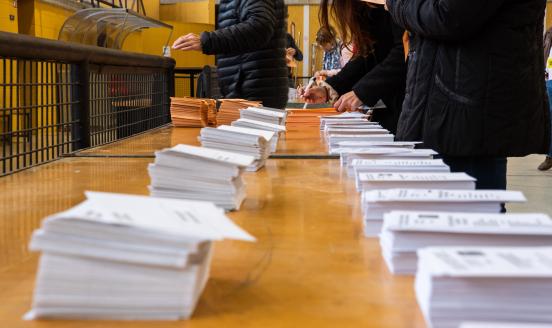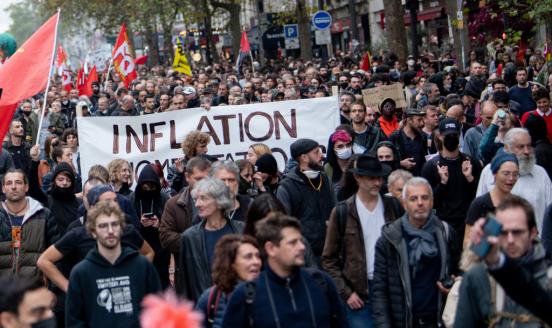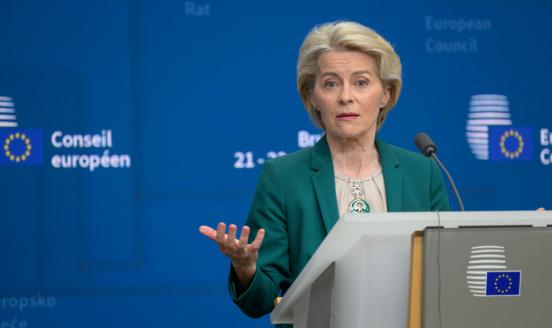What will be the impact of Europe’s next round of COVID-19 restrictions?
As COVID-19 cases surge, the choice of restrictions, and the details of their implementation, can have a major influence on the degree to which busine

After a relatively relaxed summer, many European countries are hastily imposing new coronavirus-related restrictions on popular activities. Measures include limiting or prohibiting public attendance at large events, and in many cases restricting indoor dining and shopping. A very challenging period is underway. COVID-19 Delta variant cases are high in most European countries, while the number of cases of the highly contagious Omicron variant is growing exponentially.
How are European governments responding? What will be the impact of Europe’s next round of COVID-19 restrictions? The economic impact is by no means the only effect of these restrictions, but it is an important impact. Is it possible to make already some preliminary observations on the parts of the economy most likely to be impacted?
It seems inevitable that many European countries will introduce even more stringent restrictions, but the choice of restrictions (also referred to as non-pharmaceutical interventions, or NPIs) and their impact on the public will vary greatly from one country to the next, based on a number of considerations. Different European countries are experiencing different daily case numbers. Different countries have different levels of resistance to COVID‑19 based on the number of individuals who have been vaccinated and boosted, and on the number of individuals with immunity by virtue of a previous infection.
Even where national restrictions are similar, the public response can vary greatly based on national propensities, especially the degree of confidence in the government. Finally, it is important to remember that individuals take steps voluntarily to protect themselves, even if the government does not.
To gain an insight, some brief comparisons can be made of three European countries that have taken conspicuously different approaches to handling the current COVID-19 surge: the United Kingdom, Austria and Germany. All three imposed few restrictions during summer 2021, and all have found it necessary to tighten rules in late November or early December 2021. The UK has imposed rather modest restrictions, while Germany has gone further. Austria has gone much further than any other European country to date in putting hard legal restrictions in place, and thus provides a useful point of comparison.
- The UK rushed in early December to impose hard rules about wearing masks indoors, and about nightclub hours. From 13 December, the British government strongly encouraged employees who could to work from home. Restrictions in England should be viewed as still being fairly modest, while restrictions in other nations of the UK are a bit more stringent.
- Germany had a patchwork of rules in place in the different German states/Länder, and was actively loosening restrictions as late as November 2021; however, it became clear by December that the epidemiological situation made this unworkable. Restrictions had been delayed largely because politicians were reluctant to take responsibility for potentially unpopular measures during an election campaign, but once the new government was in place, more rapid changes began to be made.
- Austria went from an environment with few compulsory restrictions to a very hard lockdown on 22 November 2021. Restaurants, bars, hotels, non-essential businesses, and cultural institutions closed for three weeks, and tourists were not permitted to enter the country. Christmas markets (which had just opened) were closed. An obligation for all to be vaccinated (subject to steep fines for those who refuse) was put in place.
Detailed comparison of results in the three countries makes clear that the details matter – different restrictions reduce contact in different ways, and some restrictions have been far more effective than others.
Selective effects of different restrictions
Restrictions reduce contact between individuals, thus slowing the spread of the virus and reducing the risk of overload of hospitals. The European Centre for Disease Prevention and Control (ECDC) has assessed available evidence on Omicron, supported by modelling the likely progress of omicron infections in Europe, and has concluded that “… only strong and immediate contact reductions will allow the avoidance of a high spike in cases caused by the Omicron variant.” The ECDC noted that measures to limit the spread of the Delta variant would likely need to be strengthened in the face of Omicron, and said: “appropriate use of face masks, teleworking, preventing crowding in public spaces, reduction of crowding on public transport, staying home when ill, maintenance of hand and respiratory hygiene measures and ensuring adequate ventilation in closed spaces all remain a priority.”
How effective have restrictions been to date?
Mobile phone data provided by Google shows the amount of time that Android smart phone or tablet users spent in workplaces, schools, transit stations, retail and recreation, parks, or at home. Comparing these with restrictions put in place and with the rise and fall of cases provides insights on the effectiveness of restrictions.
In particular, the degree to which overall contact can be reduced can be expected to have a dramatic impact on the rate of spread of Omicron.
When cases were rising in the UK (red dotted curve in Figure 1), and especially when the British government imposed strong restrictions on mobility (the vertical red lines in Figure 1), the amount of time spent at workplaces dropped by as much as 60% to 70% (the black curve in Figure 1), while time spent in retail and recreation establishments (the green curve) dropped by up to 78%. Time spent at home (the blue curve at the top) increased, of course.
But the measures that people choose to take, even in periods of few if any legal restrictions, are also important – time spent at work has continued to be depressed by 20% or more compared to pre-pandemic early 2020 levels, and time spent in retail and recreation has continued to be depressed by about 8% to 10% compared to pre-pandemic early 2020 levels.
Restrictions currently in place in England are mainly limited to obligations to wear a mask, encouragement to work from home, and some restrictions on nightclubs and other entertainment. Meanwhile, cases per day continue to skyrocket in the UK. The number of new COVID-19 cases reported on 16, 17, 18, 19 and 20 December were by far the highest daily numbers the UK has ever reported.
Figure 1: Mobility, COVID-19 incidence and government restrictions in the United Kingdom.
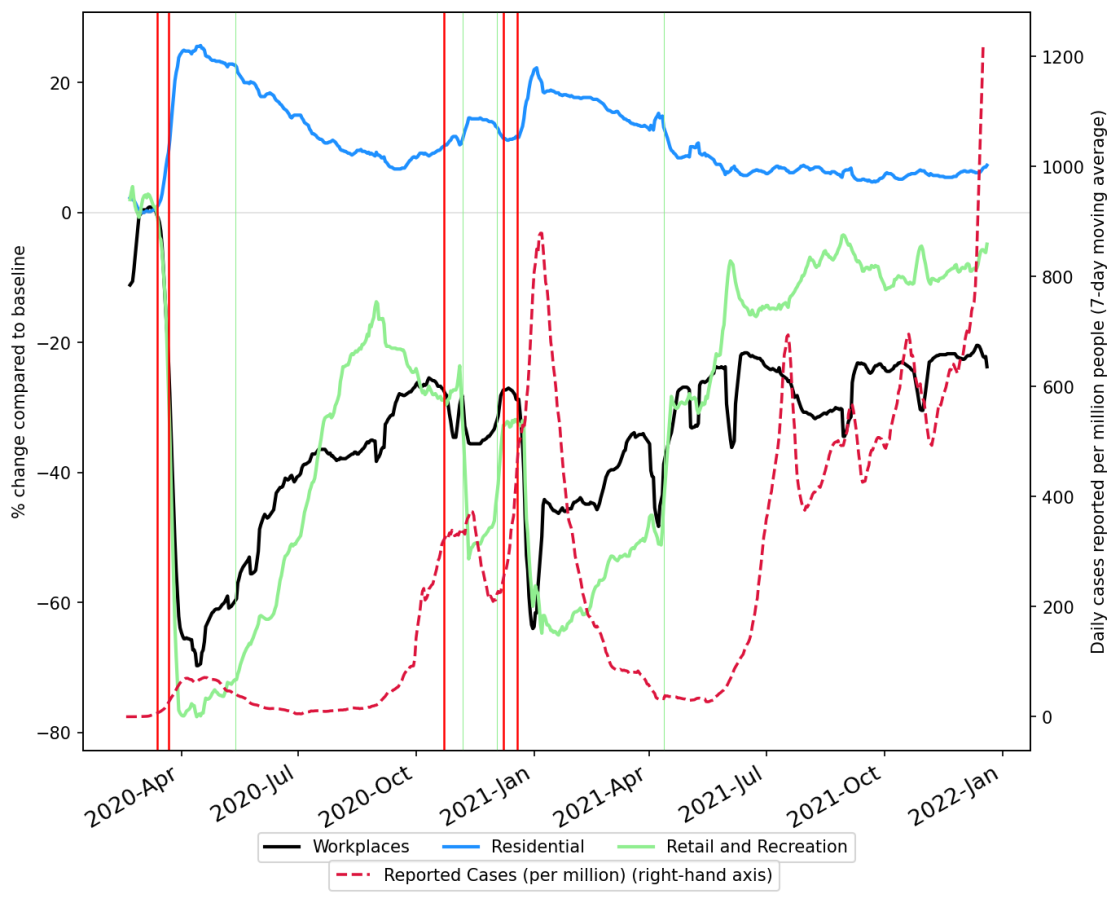
Source: Bruegel based on Our World in Data for cases and death, the COVID-19 Government Response Tracker for restrictions, Google mobility data for changes in various forms of mobility.
In Austria, time spent in retail and recreation had returned to levels comparable to pre-pandemic early 2020 levels by August 2021, but then fell some 20% in September and October. From 8 November, the government barred access to restaurants and public events to those who had not been vaccinated or had not recovered.
From 22 November, restaurants, bars, hairdressers, theatres and non‑essential shops were closed, thus barring access to the vaccinated as well. All residents were ordered to stay at home except for essential purposes, such as work, purchasing food or exercise. The imposition of these restrictions on mobility resulted in a prompt and precipitous fall of an additional 40% in time spent at retail and recreation facilities in December. Time spent at work has dropped about 20%, time spent at home has increased modestly. Perhaps most importantly, these measures appear to have been effective – the level of new COVID-19 cases per day has dropped about two thirds from its peak on about 24 November.
At present, hotels and indoor dining are, with minor exceptions, available only to those who can demonstrate that they have been either fully vaccinated or else have recovered. A negative test is no longer sufficient.
Figure 2: Mobility, COVID-19 incidence and government restrictions in Austria
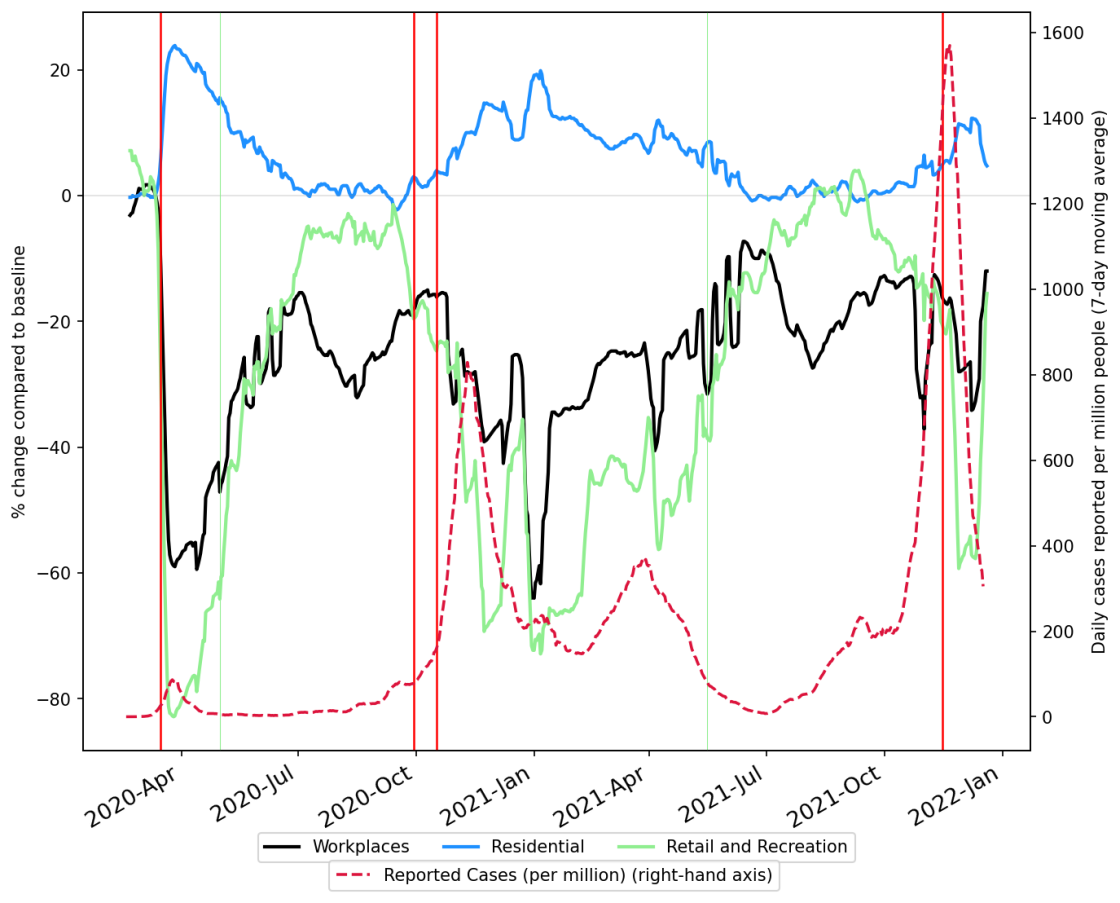
Source: See source for Figure 1.
Germany demonstrates yet another pattern. Restrictions recommended by many experts over the summer of 2020 were not put in place, which arguably could be because of the risk of political consequences in the midst of a national election campaign. A package of restrictions already in place was allowed to lapse in late November. Restrictions imposed at the level of the Länder were quite varied, in large part because some had far heavier caseloads than others. After the elections were settled and the new governing coalition began to function, however, it quickly became clear that the number of new cases was getting out of hand. In particular, hospitals and intensive-care units in many parts of Germany were overloaded with COVID-19 patients.
The restrictions introduced as a consequence required Länder with fairly high numbers of cases (nearly all Länder today) to restrict physical presence at work and the use of public transit to those who were either fully vaccinated, recovered, or who had a recent negative test certificate. Access to non-essential shops and indoor restaurants and bars in these Länder was restricted to those who were either fully vaccinated or recovered, which intentionally put some extra pressure on the unvaccinated since a test was no longer sufficient. Christmas markets in Bavaria were closed, and were either restricted or closed in many other parts of Germany. Rules were imposed requiring all workers in facilities with people in need of protection, including nursing homes and clinics (not only health care workers, but also food service and cleaning staff) to be either vaccinated or recovered. Travelers from designated ‘high-risk’ countries, including all neighbouring countries except for Luxembourg, must quarantine for ten days.
The results of the latest round of restrictions are not yet clear in the numbers. Time spent in retail and recreation establishments is dropping, but that was already the case in October, before the new restrictions. Time spent at work has been fairly stable, while time spent at home has increased slightly (but at a rate not noticeably different from that visible before the current restrictions).
But the main result of the restrictions is once again that the Delta-based wave may have been broken – the number of new cases per days is moving down rather than up.
Germany has now decided that as of 28 December, nightclubs and discos must close, public attendance at large sport and cultural event will be banned, and participation at private gatherings will be limited to ten people (irrespective of whether they are vaccinated or have recovered from COVID‑19).
Meanwhile, there is now a very serious discussion in Germany on implementing an overall obligation for all to be fully vaccinated, probably accompanied by fines for those who refuse to be vaccinated. This had long been a taboo subject, but within the last few weeks has become mainstream and now seems likely to be enacted. There is substantial public support for an overall vaccination obligation.
Figure 3: Mobility, COVID-19 incidence and government restrictions in Germany
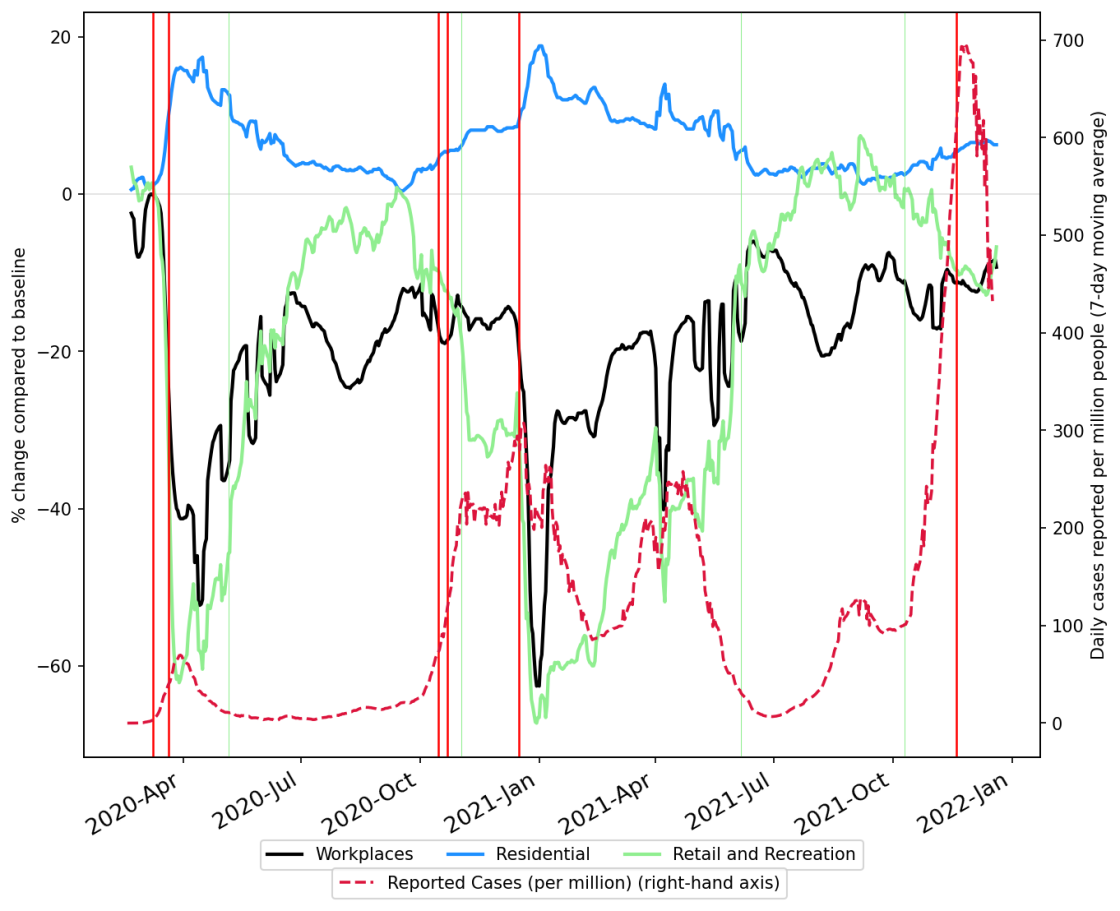
Source: See source for Figure 1.
Likely economic impact of changes in mobility
Will these reductions in mobility kill the economy? Not necessarily. The experience to date has been that each successive wave of the pandemic has caused less economic harm to European economies than the last, largely because the restrictions imposed have been increasingly sophisticated, selective and targeted. National governments have also become increasingly skilled at supporting businesses and workers financially to offset the harms.
In any case, the effects are likely to vary greatly among different economic sectors, and also among different kinds of workers.
For knowledge workers, working from home does not appear to reduce productivity. It was long thought that informal interactions in the office were important for productivity, but there was never much evidence to support that assumption. Survey results from the United States suggest that workers estimate they are 4.6% more productive overall, due in large part to commuting time saved; indeed, it appears that those who work from home plough a large part of the commuting time that they save into working an extra hour or two per day, so there may actually be a net gain in productivity. This means that for knowledge workers, the return to working from home is probably not a serious problem; however, not every job is amenable to working from home.
Restrictions on large gatherings will surely continue to have a dramatic impact on entertainment; however, the experience of previous waves has been that restrictions on public gathering are alone not likely to be sufficient to break the current pandemic wave.
Whether a return to distance learning is likely is hard to predict. Parents are extremely weary of school closings and EU governments can be expected to avoid school closings for as long as they can. Moreover, the role that children might play in the next wave of the pandemic is currently unclear.
With the emergence of Omicron, many European countries have restricted travel outside of Europe. Travel within the Schengen area has become more difficult, for instance because of obligations to quarantine for a few days in some countries, and this might intensify. In addition, many individuals will choose to avoid travel, even if it is not prohibited – in the summer of 2020, hotel bookings in the EU were close to normal, but a much higher fraction than usual was from residents of the EU countries in which the hotel was located. As non-essential cross-border travel becomes increasingly difficult if not impossible, a substantial impact on tourism can be expected, along with lodging, restaurants, and travel by air, rail, or sea, as was already the case with the restrictions introduced when the pandemic first appeared in 2020. It has long been clear that, Schengen or no Schengen, countries with low or moderate levels of infection will not wish to welcome travellers from countries with high levels of infection. But these impacts will manifest not only because of hard restrictions, but because of people voluntarily distancing more than they did when the pandemic did not seem as serious as it seems now.
An impact on retail sales is also likely, but the degree to which this happens is likely to depend on the specifics of any further restrictions. If non-essential businesses are forced to close, or if individuals are prohibited from leaving home other than for essential purposes, retail sales from brick-and-mortar stores will presumably be impacted. Some sales will simply not be made, other sales will shift to online channels, as happened during earlier stages of the pandemic, and as has recently been the case in Austria.
Responding to the next wave
The growing COVID-19 wave based on the Omicron variant is proving to be of even greater concern than the serious wave based on the Delta variant. The ECDC has assessed as very high the likelihood of the Omicron variant spreading. The ECDC also assesses the impact of this spread to potentially be very serious, and in particular has warned, “the exponential rise in cases and resulting hospitalisations will probably overwhelm healthcare systems” already under pressure from Delta. The risk of severe outcomes appears to be less under Omicron than under Delta; nonetheless, it is very likely that the sheer volume of infections from this highly contagious variant will overwhelm many healthcare facilities.
New restrictions that are tougher than many of those already introduced in recent months are likely to be called for to reduce contacts and slow the spread of Omicron, and thus avoid more overload of healthcare systems, and especially of ICUs, than is strictly necessary.
What recent experience strongly suggests is that the choice of restrictions, and the details of their implementation, can have a major influence on the degree to which business is impacted. Policymakers are sure to pay close attention to experience with restrictions in the coming weeks and months.
Recommended citation:
Marcus, J.S. and L. Guetta-Jeanrenaud (2021) ‘What will be the impact of Europe’s next round of COVID-19 restrictions?’ Bruegel Blog, 23 December
